
|
Sale 108
NY International Coin Auction January 8-10, 2019
| Lot |
Photo |
Description |
Realized |
Lot 165 |
 |
Judaea, Bar Kokhba Revolt. Silver Zuz (3.40 g), 132-135 CE. Year 2 (133/4 CE). 'Simon', bunch of grapes with leaf and tendril. Rev. 'Year two of the freedom of Israel' (Paleo-Hebrew), upright palm branch. Hendin 1394; Mildenberg 41 (O8/R12''); TJC 248. Struck on a wide flan with traces of luster present. Extremely Fine. Estimate Value $500 - UP
From the Palm Desert Collection. Purchased from H. Berk in the 1980s.
View details and enlarged photos
| Realized
$1,260 |
Lot 166 |
 |
Judaea, Bar Kokhba Revolt. Silver Zuz (3.25 g), 132-135 CE. Year 2 (133/4 CE). 'Simon' (Paleo-Hebrew) within wreath of thin branches wrapped around eight almonds, with a medallion at top and tendrils at bottom. Rev. 'Year two of the freedom of Israel' (Paleo-Hebrew), upright palm branch. Hendin 1401; Mildenberg 59 (O14/R29'); TJC 246; Hendin 1401. Lightly toned. Extremely Fine. Estimate Value $500 - UP
From the Palm Desert Collection.
The popular wreathed paleo-Hebrew legend naming Simon [bar Kokhba] and palm branch types appear on this zuz of the second year (133/4 CE) of the Bar Kokhba War, but the treatment of the five-letter obverse legend is different that it normally appears.
View details and enlarged photos
| Realized
$1,680 |
Lot 167 |
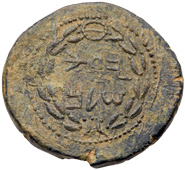 |
Judaea, Bar Kokhba Revolt. Æ Large Bronze (26.30 g), 132-135 CE. Year 2 (133/4 CE). 'Jerusalem' (Paleos-Hebrew within wreath with medallion at top. Rev. 'Year two of the freedom of Israel' (Paleo-Hebrew), amphora with two handles. Hendin 1404; Mildenberg 18 (O5/R12); TJC 255. Struck on a huge, medallic flan. Incredibly fine artistic style. Pale olive-green patina with earthen highlights. A numismatic prize. Capable of setting a record price for a large Bar Kokhba year 2 'Abu Jara' bronze. Extremely Fine. Estimate Value $50,000 - UP
From the S. Moussaieff Collection; Ex Robert Deutsch, Arnold Spaer Coll, Oct. 5, 2004, lot 237. (Realized $66,500). This lot has been officially exported from Israel through the Israel Antiquities Authority.
The large bronze denomination of the second year (133/4 CE) of the Bar Kokhba War is often known by the Arabic nickname "Abu Jara" meaning "father of the jar" because of its very large size and its prominent depiction of an amphora or jar ("jara"). Unlike the majority of the Bar Kokhba coins struck in the second year, this one names Jerusalem rather than Simon bar Kokhba on the obverse. This example is especially desirable as it is struck from the very finest of the Abu Jara dies.
View details and enlarged photos
| Realized
$72,000 |
Lot 168 |
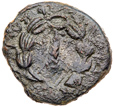 |
Judaea, Bar Kokhba Revolt. Æ Medium Bronze (7.38 g), 132-135 CE. Year Two, Wide lyre. 'For the freedom of Jerusalem' (Paleo-Hebrew), palm branch within wreath. Rev. 'Year two of the freedom of Israel' (Paleo-Hebrew), wide lyre with four strings. Hendin 1407; Mildenberg 30 (O2/R8); TJC 296. Very Rare. Uniform dark reddish-brown patina. Very Fine. Estimate Value $400 - UP
From the Palm Desert Collection.
View details and enlarged photos
| Unsold |
Lot 169 |
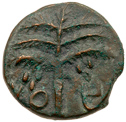 |
Judaea, Bar Kokhba Revolt. Æ Medium Bronze (12.49 g), 132-135 CE. Irregular issue. Year 2 (133/4 CE). 'Simon' (Paleo-Hebrew; retrograde), seven-branched palm tree with two bunches of dates. Rev. 'Year two of the redemption of Israel' (Paleo-Hebrew; partly retrograde), vine leaf on tendril. Hendin 1408a; Mildenberg 195.1 (O27/R33; this coin); TJC 259a. Extremely Rare - only three specimens recorded by Mildenberg, this being the example used to illustrate the dies. Dark green patina. Choice Very Fine. Estimate Value $1,000 - UP
From the Dr. Patrick Tan Collection
Ex Sternberg 6 (25 November 1976), 411.
View details and enlarged photos
| Realized
$1,500 |
Lot 170 |
 |
Judean, Bar Kokhba Revolt, 132-135 CE. AR Sela (13.76 g). Undated, minted Year Three (134/135 CE. 'Shim'on' (in Paleo-Hebrew), Facade of the Jerusalem Temple, showbread table inside seen from end in center of entrance. Rev. ' For the Freedom of Jerusalem' (in Paleo-Hebrew), Bundle of lulav with etrog at left. Hendin 1411; Meshorer 267; Mildenberg 77. Pleasing antique toning with traces of overstiking as usual. Choice Very Fine. Estimate Value $5,000 - UP
Ex Ira & Larry Goldberg Sale 59, May 30, 2010, lot 2220; Ex Leu 86, 5 May 2003, lot 597.
View details and enlarged photos
| Realized
$9,000 |
Lot 171 |
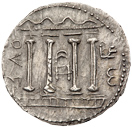 |
Judaea, Bar Kokhba Revolt. Silver Sela (14.29 g), 132-135 CE. Undated, attributed to year 3 (134/5 CE). 'Simon' (Paleo-Hebrew), tetrastyle façade of the Temple of Jerusalem; show bread table or Ark of the Covenant in chest form with semicircular lid and short legs, seen from a narrow side; above façade, wavy line. Rev. 'For the freedom of Jerusalem' (Paleo-Hebrew), lulav with etrog at left. Hendin 1413; Mildenberg 9.165 (O17/R65; this coin); TJC 269. Boldly struck on a beautiful full flan. Toned. Extremely Fine. Estimate Value $5,000 - UP
From the Palm Desert Collection. Ex Superior (10 June 1987), Buddy Ebsen Collection, 4208.
View details and enlarged photos
| Realized
$21,000 |
Lot 172 |
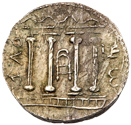 |
Judaea, Bar Kokhba Revolt. Silver Sela (14.73 g), 132-135 CE. Undated, attributed to year 3 (134/5 CE). 'Simon' (Paleo-Hebrew), tetrastyle façade of the Temple of Jerusalem; show bread table or Ark of the Covenant in chest form with semicircular lid and short legs, seen from a narrow side; above façade, wavy line. Rev. 'For the freedom of Jerusalem' (Paleo-Hebrew), lulav with etrog at left. Hendin 1413; Mildenberg 95 (O17/R65); TJC 269. Overstruck on a tetradrachm of Galba from Antioch (seen upside down). Toned. Extremely Fine. Estimate Value $5,000 - UP
From the S. Moussaieff Collection, This lot has been officially exported from Israel through the Israel Antiquities Authority.
Instead of the + symbol that appeared above the Temple façade in the second year (133/4 CE) of the Bar Kokhba War and on some of the undated sela'im of the third year, this sela features a wavy line instead. The precise meaning of this new design element is not certain. If the + symbol was intended as the star of Bar Kokhba's name, does its replacement with a wavy line mean that the rebels had begun to give up on his messianic quality, or does it simply represent either the roof of the temple or the golden vine that adorned it during the time of Herod?
View details and enlarged photos
| Realized
$15,600 |
Lot 173 |
 |
Judaea, Bar Kokhba Revolt. Silver Zuz (2.88 g), 132-135 CE. Undated, attributed to year 3 (134/5 CE). 'Simon' (Paleo-Hebrew) within wreath of thin branches wrapped around eight almonds, with a medallion at top and tendrils at bottom. Rev. 'For the freedom of Jerusalem' (Paleo-Hebrew), elongated lyre with three strings. Hendin 1419; Mildenberg 70 (O14/R42); TJC 272. Boldly stuck and well centered. Luster still present. Mostly untoned. Superb Extremely Fine. Estimate Value $600 - UP
From the Palm Desert Collection. Purchased from Superior's Frank Grove and Robert Grover Sale, June 11-12, 1986, 1461.
View details and enlarged photos
| Realized
$2,100 |
Lot 174 |
 |
Judaea, Bar Kokhba Revolt. Silver Zuz (3.33 g), 132-135 CE. Undated, attributed to year 3 (134/5 CE). 'Shim'on', in two lines within a wreath of thin branches wrapped around eight almonds, medallion at top, and tendrils below, pair of dots, one inside and one outside, between each section. Rev. 'For the freedom of Jerusalem', palm branch. Hendin 1425; Mildeberg 103.26 (O16/R71); TJC 279. Areas of oxidation on edge. Extremely Fine. Estimate Value $600 - UP
From the Palm Desert Collection. Ex Abraham Bromberg Collection, pt. I (Superior, 5 December 1991), 168; NFA III (27 March 1976), 145.
View details and enlarged photos
| Realized
$1,860 |
Lot 175 |
 |
Judaea, Bar Kokhba Revolt. Silver Zuz (3.15 g), 132-135 CE. Undated, attributed to year 3 (134/5 CE). 'Shim'on', in two lines within a wreath of thin branches wrapped around eight almonds, medallion at top, and tendrils below. Rev. 'For the freedom of Jerusalem', two trumpets upright, dot between (faint). Hendin 1426; Mildeberg 131 (O19/R91); TJC 276. Portions of the undertype visible on the reverse. Toned. Extremely Fine. Estimate Value $750 - UP
From the Palm Desert Collection. Purchased from Superior in the 1980s.
View details and enlarged photos
| Realized
$1,440 |
Lot 176 |
 |
Judaea, Bar Kokhba Revolt. Silver Zuz (3.27 g), 132-135 CE. Undated, attributed to year 3 (134/5 CE). 'Simon' (Paleo-Hebrew) within wreath of thin branches wrapped around eight almonds, with a medallion at top and tendrils at bottom; pairs of dots between each section of wreath. Rev. 'For the freedom of Jerusalem' (Paleo-Hebrew), fluted jug with handle on left; in right field, willow branch. Hendin 1427; Mildenberg 133 (O19/R93); TJC 283. Partial legend of undertype visible on reverse. Extremely Fine. Estimate Value $500 - UP
From the Palm Desert Collection. Ex Superior (7 June 1984), 1522.
View details and enlarged photos
| Realized
$1,680 |
Lot 177 |
 |
Judaea, Bar Kokhba Revolt. Silver Zuz (3.33 g), 132-135 CE. Undated, attributed to year 3 (134/5 CE). 'Simon' (Paleo-Hebrew), bunch of grapes with leaf and tendril. Rev. 'For the freedom of Jerusalem' (Paleo-Hebrew), upright palm branch. Hendin 1430; Mildenberg 170 (O21/R103); TJC 272c. Struck on a denarius of Titus with a clear portrait of the emperor exhibiting a "grape-textured" beard. Toned. Basically as struck. Sharpness of Very Fine / Extremely Fine. Estimate Value $1,000 - UP
From the Palm Desert Collection. Purchased from A. Saslow in the 1980s.
View details and enlarged photos
| Realized
$4,080 |
Lot 178 |
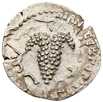 |
Judaea, Bar Kokhba Revolt. Silver Zuz (3.23 g), 132-135 CE. Undated, attributed to year 3 (134/5 CE). 'Simon' (Paleo-Hebrew), bunch of grapes with leaf and tendril. Rev. 'For the freedom of Jerusalem' (Paleo-Hebrew), upright palm branch. Hendin 1430; Mildenberg 171 (O21/R96); TJC 272c. Struck on a huge, wide flan with legends of the host coin (a drachm of Trajan) shown on both sides. Traces of luster present. Superb Extremely Fine. Estimate Value $750 - UP
From the Palm Desert Collection. Purchased from Superior in the 1970s or 1980s.
View details and enlarged photos
| Realized
$1,920 |
Lot 179 |
 |
Judaea, Bar Kokhba Revolt. Silver Zuz (2.99 g), 132-135 CE. Undated, attributed to year 3 (134/5 CE). 'Simon' (Paleo-Hebrew), bunch of grapes with leaf and tendril. Rev. 'For the freedom of Jerusalem' (Paleo-Hebrew), upright palm branch. Hendin 1430; Mildenberg 145.6 (O11/R61); TJC 272c. The Mildenberg plate coin. Toned. Choice Very Fine. Estimate Value $500 - UP
From the Palm Desert Collection. Ex Abraham Bromberg Collection, pt. I (Superior, 5 December 1991), 190.
View details and enlarged photos
| Realized
$1,800 |
Lot 180 |
 |
Judaea, Bar Kokhba Revolt. Silver Zuz (3.45 g), 132-135 CE. Undated, attributed to year 3 (134/5 CE). 'Simon' (Paleo-Hebrew), bunch of grapes with leaf and tendril. Rev. 'For the freedom of Jerusalem' (Paleo-Hebrew), two upright trumpets without dot between. Hendin 1431; Mildenberg 162 (O21/R85); TJC 277. No dot between trumpets. Lightly toned. Superb Extremely Fine. Estimate Value $750 - UP
From the Palm Desert Collection. Ex Superior (21 November 1983), 55.
View details and enlarged photos
| Realized
$1,560 |
Lot 181 |
 |
Judaea, Bar Kokhba Revolt. Silver Zuz (2.97 g), 132-135 CE. Undated, attributed to year 3 (134/5 CE). 'Simon' (Paleo-Hebrew), bunch of grapes with leaf and tendril. Rev. 'For the freedom of Jerusalem' (Paleo-Hebrew), two upright trumpets, dot between. Hendin 1431; Mildenberg 167 (O21/R107); TJC 277. Portrait of Vespasian undertype visible on the reverse. Toned. About Extremely Fine. Estimate Value $750 - UP
From the Palm Desert Collection.
View details and enlarged photos
| Realized
$990 |
Lot 182 |
 |
Judaea, Bar Kokhba Revolt. Silver Zuz (3.60 g), 132-135 CE. Undated, attributed to year 3 (134/5 CE). 'Simon' (Paleo-Hebrew), bunch of grapes with leaf and tendril. Rev. 'For the freedom of Jerusalem' (Paleo-Hebrew), fluted jug with handle on left; in right field, willow branch. Hendin 1433; Mildenberg 194 (O24/R125); TJC 285. Delicately toned. Superb Extremely Fine. Estimate Value $500 - UP
From the Palm Desert Collection.
View details and enlarged photos
| Realized
$1,440 |
Lot 183 |
 |
Judaea, Bar Kokhba Revolt. Silver Zuz (3.33 g), 132-135 CE. Undated, attributed to year 3 (134/5 CE). 'Simon' (Paleo-Hebrew), bunch of grapes with leaf and tendril. Rev. 'For the freedom of Jerusalem' (Paleo-Hebrew), elongated lyre with three strings. Hendin 1435; Mildenberg 203 (O24/R131); TJC 274. Toned. Superb Extremely Fine. Estimate Value $750 - UP
From the Palm Desert Collection. Purchased from NFA in the 1980s.
View details and enlarged photos
| Realized
$1,560 |
Lot 184 |
 |
Judaea, Bar Kokhba Revolt. Silver Zuz (3.39 g), 132-135 CE. Undated, attributed to year 3 (134/5 CE). 'Simon' (Paleo-Hebrew), bunch of grapes with leaf and tendril. Rev. 'For the freedom of Jerusalem' (Paleo-Hebrew), elongated lyre with three strings. Hendin 1435; Mildenberg 203 (O24/R131); TJC 274. Well struck with traces of luster present. Mostly untoned. Superb Extremely Fine. Estimate Value $600 - UP
From the Palm Desert Collection. Purchased from Superior in the 1980s; Previously from Schweizerische Kreditanstalt Numismatische Abt, Bern lot 198.
View details and enlarged photos
| Realized
$1,740 |
Lot 185 |
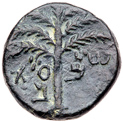 |
Judaea, Bar Kokhba Revolt. Æ Medium Bronze (12.54 g), 132-135 CE. Undated, attributed to year 3 (134/5 CE). 'Simon' (Paleo-Hebrew), seven-branched palm tree with two bunches of dates. Rev. 'For the freedom of Jerusalem' (Paleo-Hebrew), vine leaf on tendril. Hendin 1437; Mildenberg - (O9/R102); TJC 289. Olive and brown patina. Choice Very Fine. Estimate Value $200 - UP
From the Palm Desert Collection. Ex Superior (10 August 1983), 158.
View details and enlarged photos
| Realized
$1,050 |
Lot 186 |
 |
Judaea, Bar Kokhba Revolt. Æ Small Bronze (4.88 g), 132-135 CE. Undated, attributed to year 3 (134/5 CE). 'Simon' (Paleo-Hebrew), seven-branched palm tree with two bunches of dates. Rev. 'For the freedom of Jerusalem' (Paleo-Hebrew), bunch of grapes with branch and small leaf. Hendin 1440; Mildenberg 158 (O4/R8); TJC 302b. Olive and brown patina. Choice Very Fine. Estimate Value $200 - UP
From the Palm Desert Collection. Purchased from Superior in the 1980s.
View details and enlarged photos
| Realized
$690 |
Lot 187 |
 |
Jewish Reference Coinage, M. Aemilius Scaurus and Pub. Plautius Hypsaeus. Silver Denarius (3.83 g), 58 BC. Rome. M SCAVR / AED CVR in two lines above, EX S C across field, REX ARETAS in exergue, the Nabatean king Aretas kneeling to right, extending olive-branch and holding reins, before camel standing right. Rev. P HVPSAE / AED CVR in two lines above, CAPTV to right, C HVPSAE COS / PREIVE in two lines in exergue, Jupiter driving quadriga left; below horses' forelegs, scorpion. Hendin 1441; Crawford 422/1b; Sydenham 913; Aemilia 8. Boldly sturck, lightly toned, and lustrous. Perfectly centered. Nearly Mint State. Estimate Value $400 - UP
From the Palm Desert Collection. Purchased from NFA in the 1970s or 1980s.
During the first century, it was normal for a moneyer to highlight some important event from his family's past. This was because for the Roman aristocracy an illustrious past was extremely important for advancing one's political career. Here, however, M. Aemilius has deviated from the norm, depicting an event from his own career, the first such instance in Roman coinage. While serving as Governor of Syria, Scaurus invaded Nabataea, laying waste much of its territory. Although he was unable to conquer king Aretas' stronghold, through an intermediary he was able to convince Aretas to pay a substantial bribe (300 talents) for him to desist. As the event is presented on the coin one would think that the Nabataeans were soundly defeated and that Aretas begged for mercy, but this is mere propagandistic opportunism on the part of Scaurus.Unlike the obverse, the reverse follows tradition by commemorating a past deed of the moneyer, recalling that it was his ancestor, the consul Gaius Hypsaeus, who captured the Volscian town of Privernum.
View details and enlarged photos
| Realized
$552 |
Lot 188 |
 |
Jewish Reference Coinage, A. Plautius. Silver Denarius (4.00 g), 55 BC. Rome. A PLAVTIVS AED CVR S C, turreted head of Cybele right. Rev. BACCHIVS in exergue, IVDAEVS to right, Bacchius kneeling right beside camel, holding forth olive branch. Hendin 1443; Crawford 431/1; Sydenham 932; Plautia 13. A marvelous example with old cabinet tone. Extremely Fine. Estimate Value $500 - UP
From the Palm Desert Collection. Purchased from Superior in the 1970s or 1980s.
View details and enlarged photos
| Realized
$2,100 |
Lot 189 |
 |
Judaea, Roman Judaea. Domitian. Æ (4.91 g), AD 81-96. Judaea Capta issue. Caesarea Maritima, ca. AD 83 or later. Laureate head of Domitian right. Rev. Nike advancing left, holding wreath and trophy. Hendin 1456; TJC 393; RPC 2306. Pleasing uniform glossy brown patina. Extremely Fine. Estimate Value $400 - UP
From the Palm Desert Collection.
View details and enlarged photos
| Realized
$456 |
Lot 190 |
 |
Jewish Reference Coinage, Vespasian. Gold Aureus (7.16 g), AD 69-79. Judaea Capta type. Rome, AD 69/70. IMP CAESAR VESPASIANVS AVG, laureate head of Vespasian right. Rev. IVDAEA in exergue, Jewess seated right, head resting on hand in attitude of mourning; behind, trophy. Hendin 1464; RIC 1; BN 20-2; BMC 31-4; Calicó 643. Quite pleasing and problem free. The surfaces and devices are quite appealing. About Very Fine. Estimate Value $10,000 - UP
From the S. Moussaieff Collection, This lot has been officially exported from Israel through the Israel Antiquities Authority.
First coin of the standard 'Judaea Capta' series. In the 'Judaea Capta' coinage, the seated personified Judaea evokes the iconographic language of the defeated and degraded prisoner. The conquered province type has its own set of gestures expressing a mournful or abject context, which are derived from Roman funerary iconography. They include an attitude formed by the resting of the chin in the hand, a pose that evokes pensiveness, uncertainty, and grief with overtones of repentance or lamentation. Additionally, the mourner is shown with hunched shoulders, and a bowed and covered head. The depiction of the personified province recollects the Biblical description of the besieged Jerusalem by the prophet Isaiah (ca. 700 BCE): "For Jerusalem is ruined, and Judah is fallen… Thy men shall fall by the sword and thy mighty in the war. And her gates shall lament and mourn, and she, being desolate, shall sit upon the ground" (Isaiah 3:8-9; 25-26).The imposing military trophy standing to the left of the picture looms over the back of the vanquished Judaea, taunting the humiliated figure, re-enforcing the fact that the weapons used to resist Rome are now spoils to the victors; they no longer hold power.
View details and enlarged photos
| Realized
$15,600 |
Lot 191 |
 |
Vespasian. Gold Aureus (7.00 g), AD 69-79. Judaea Capta type. Rome, AD 72/3. IMP CAES VESP AVG P M COS IIII, laureate head of Vespasian right. Rev. Emperor standing right, resting foot on helmet, holding spear and parazonium; to right, Judaea seated on ground in attitude of mourning; between them, palm tree. Hendin 1466; RIC 363; BN 64; BMC 78; Calicó 587. Very Rare. Rim bruises and scratches. Fine. Estimate Value $3,000 - UP
From the S. Moussaieff Collection, This lot has been officially exported from Israel through the Israel Antiquities Authority.
View details and enlarged photos
| Realized
$8,400 |
Lot 192 |
 |
Vespasian. Gold Aureus (6.98 g), AD 69-79. Judaea Capta type. Lugdunum, AD 72. MP CAES VESPAS AVG P M TR P IIII P P COS IIII, laureate head of Vespasian right. Rev. DE IVDAEIS, trophy. Cf. Hendin 1472; RIC 1179; BN 305; BMC 402; Calicó 627c. Very Rare. Fine. Estimate Value $3,500 - UP
From the S. Moussaieff Collection, This lot has been officially exported from Israel through the Israel Antiquities Authority.
This gold aureus belongs to the vast coin series struck to celebrate the victory of Vespasian (and his son Titus) in the First Jewish Revolt, a bloody conflict that rocked the eastern territories of the Roman Empire between AD 66 and 73. Although the last pocket of Jewish rebels was only defeated at the desert fortress of Masada in AD 73, the major fighting was over and Titus had captured the Judaean capital at Jerusalem in AD 70. The Holy City was besieged for seven terrible months, during which the defenders were decimated by starvation, disease, and factional conflict among the rebel leadership. At last, Roman forces stormed Jerusalem, slaughtering and enslaving the defenders and plundering the sacred wealth of the Second Temple. Slaves and treasure were carried off to Rome by Titus in AD 71 to adorn the great triumph that he was to celebrate along with his father. This procession, in which a variety of Temple instruments, including a menorah, were carried before the Roman people is immortalized in a famous frieze from the Arch of Titus in Rome. The trophy type on the reverse of the present coin, with the simple statement, DE IVDAEIS ("From the Judaeans") serves as shorthand for the vast booty that was taken from Jerusalem and especially from the Temple. The historian Josephus reports that the quantities of gold, ivory, jewelry, and purple cloth in Vespasian's triumph that the procession resembled "a running river of wealth." The emperor subsequently tapped this river to cover the expenses of a grand new project to reshape Rome itself. He ordered an artificial lake belonging to the palace complex of the dead and disgraced Nero to be drained and used as the foundation for an enormous amphitheater. This amphitheater was to be used for the display of the gladiator shows and wild beast hunts that were such popular entertainments for the Roman public. It was officially described as the Flavian Amphitheater, but came to be known as the Colosseum after its location near a colossal statue of Nero in the guise of the sun god. This aureus and other gold coins produced in the context of Vespasian's triumph very well may have been struck from the gold objects carried off from conquered Judaea. And some were struck in order to pay for the construction of the Colosseum, which in its own somewhat sinister way was also DE IVDAEIS.
View details and enlarged photos
| Realized
$10,800 |
Lot 193 |
 |
Vespasian. Gold Aureus (7.23 g), AD 69-79. Judaea Capta type. Lugdunum, AD 71. IMP CAESAR VESPASIANVS AVG TR P, laureate head of Vespasian right. Rev. TRIVMP AVG in exergue, emperor on triumphal quadriga right, holding palm and eagle-tipped scepter, being crowned by Victory standing behind him and accompanied by trumpeter; before horses, soldier escorting captive. Hendin 1475; RIC 1127; BN 17; BMC 397; Calicó 689. An important Jewish rarity. Very Fine. Estimate Value $30,000 - UP
From the S. Moussaieff Collection. We sold a similar (but slightly inferior example in Goldberg 41 (27 May 2007), lot 2786) and again in Goldberg 90, lot 3044 which realized $78,000. This lot has been officially exported from Israel through the Israel Antiquities Authority.
Simon bar Giora Aureus
This very rare 'Judaea Capta' - themed aureus, minted to commemorate the recently concluded Jewish War, is most notable for its reverse type. The exergual inscription simply reads: TRIVMP AVG (Triumph of Augustus [Vespasian]). Depicted with particular clarity is the imperial quadriga in the way it would have appeared in the triumphal procession, preceded by a soldier who looks back at the emperor, while escorting a captive with hands bound behind. Robert Deutsch (BAR Jan/Feb 2010, 51-53) identifies the captive as the most important leader of Jerusalem in the Jewish War, Simon bar Giora.
The triumph celebrated by Vespasian and Titus in 71 A.D. was a magnificent showcase of the abundance gleaned from the victory over the destroyed province. Booty taken back to Rome after the war was prodigious. When the Romans entered the Temple court, "so glutted with plunder were the troops, one and all, that throughout Syria the standard of gold was depreciated to half its former value" (Josephus, de Bello Judaico, 6.316-322).
The triumph itself was described in vivid detail by Josephus, who was an eye-witness to the event (de Bello Judaico, 7.24): "…as dawn was breaking [Titus and Vespasian] emerged, crowned with laurel wreaths and wearing the time-honored purple clothes…. It is impossible to do justice in the description of the number of things to be seen and the magnificence of everything… For almost all the remarkable and valuable objects which have ever been collected … were on that day massed together, affording a clear demonstration of the might of the Roman Empire. The quantities of silver, gold and ivory, worked into every conceivable form, were not like those usually carried in a triumph, but resembled, as it were, a running river of wealth… The greatest amazement was by the floats… For many were three or four stories high… Standing on his individual float was the commander of each of the captured cities showing the way he had been taken prisoner… Spoil in abundance was carried past. None of it compared with that taken from the Temple in Jerusalem, a golden table [the showbread table], and a golden lamp stand [the menorah]… The Law [Torah; The Five Books of Moses] was carried last of all the spoil.
The procession culminated at the Temple of Jupiter Capitolinus… where they still had to wait for the traditional moment when the news was brought of the death of the enemy leader. In this case he was Simon bar Giora, who had passed in procession with captives and had been dragged under the lash, with his head in a noose, to a spot near the Forum. That is the traditional place at Rome for the execution of those condemned to death for war crimes. When his end was announced and a general cheer had arisen, they started the sacrifices…."
View details and enlarged photos
| Realized
$66,000 |
Lot 194 |
 |
Vespasian. Gold Aureus (7.36 g), AD 69-79. Judaea Capta Issue. Antioch, AD 72/3. IMP VESPAS AVG P M TRI P P P COS IIII, laureate head of Vespasian left. Rev. PAX AVG-VSTI, Vespasian nude except for cloak floating behind, standing facing, head left, holding spear and raising draped woman (Jewess?) r. wearing a 3-tipped crown, who clasps his right hand with hers. Hendin -; RIC 2, pl. 82, 1550; RPC 1924; BMC 504; Calicó 664 (this coin illus.). A great rarity! This is the plate coin in Calicó and is listed as R2. It is in fact much rarer. Toned. Choice Very Fine. Estimate Value $30,000 - UP
From the S. Moussaieff Collection, This lot has been officially exported from Israel through the Israel Antiquities Authority.
The eight years between AD 66 and 73 had been long and exhausting for Rome indeed. In AD 66, a revolt against Roman rule broke out in Judaea that had the potential to destabilize the Roman East. When Cestius Gallus, the legate of Syria, failed to crush the rebels and suffered the defeat of an entire legion, command of the war was transferred to the general Vespasian. Despite Vespasian's early successes against the rebels in Galilee, the conflict dragged on. It was a tiring, dirty affair, often involving massacre and atrocity on both sides. At the same time, the Jewish and Greek populations that had long lived side by side in the cities of Syria and Judaea fell upon one another. In the spring of AD 68, Vespasian pressed his advance into Judaea proper, systematically capturing rebel strongholds and crushing resistance on his inexorable march towards Jerusalem. Then, the unthinkable happened.
On June 9, AD 68, the increasingly unpopular emperor Nero killed himself in order to escape a potentially worse fate at the hands of his senatorial enemies and Servius Salpicius Galba, the rebel governor of Hispania Tarraconensis. This event sparked the infamous Year of the Four Emperors (AD 69), in which Galba and his rivals, M. Salvius Otho and Aulus Vitellius embroiled the Roman world in bloody civil war as they struggled to claim the imperial purple. Vespasian joined the fray as the fourth imperial claimant and was ultimately successful, his forces crushing the legions of Vitellius at Bedriacum and taking possession of Rome in the late autumn of AD 69.
While all of this chaos was taking place in the West, Vespasian had left his son, Titus, in command in Judaea. Titus continued to prosecute the war against the Jewish rebels and besieged a Jerusalem crowded with refugees in AD 70. After a grueling seven months, bringing the defenders to their knees through starvation, disease and factional conflict, Titus at last stormed the city, plundering the Temple and slaughtering or enslaving many of the survivors. Victory was in Roman hands and in AD 71 Titus embarked for Rome to share in a great triumph with his father. Nevertheless, pockets of Jewish rebels still remained in the countryside to harass the Roman victors. Only in AD 73, after the capture of the Dead Sea fortress of Masada and the mass suicide of its Jewish defenders, was the First Jewish Revolt fully repressed. Rebuilding after years of destruction in both the East and West could begin in earnest.
The present gold aureus struck in AD 72-73 celebrates the much longed-for return of "Augustan Peace" to the Roman Empire. The reverse features Vespasian represented as a spear-wielding hero (this heroic quality is indicated by the emperor's nudity) raising up a female figure wearing a turreted headdress. She is normally described as Tyche (Roman Fortuna), the Greek personification of a city's fortune, but it is somewhat unclear how she should be understood here. On the one hand, she could represent the oikoumene � the entirety of the Greco-Roman world � freed from war by the victories of Vespasian (and Titus). On the other hand, since this coin was struck at Antioch, Tyche here may represent the fortune of that city in its capacity as the capital of the Roman province of Syria. As Judaea was under the jurisdiction of the Syrian legates and the province at large had suffered great upheavals over the course of the First Jewish Revolt, it would have been fitting to advertise the restoration of Syria�s fortune at the conclusion of the war.
A further comment by David Hendin, American Numismatic Society and author of a Guide of Biblical Coins:
Among all of the known coins of Vespasian, the only subjugated men or women depicted are Jews or personifications of Jews in relation to the Roman victory in the Jewish War (66 - 73 AD). Thus this rare coin is almost certainly a local-Antiochean-variation on the Judaea Capta theme, but instead suggesting that this victory was pointing to "The Emperor's Peace."
Mattingly suggests that the kneeling woman is wearing a "crown of towers." If this was true it would suggest that the Jewess was also representing the city goddess of Jerusalem, in her defeat. However, this specimen is better centered and better struck than the RIC specimen and the crown appears to have three pointed tips rather than three rectangular towers as usually seen related to a city goddess figure.
View details and enlarged photos
| Realized
$72,000 |
Lot 195 |
 |
Titus. Silver Denarius (3.29 g), as Caesar, AD 69-79. 'Judaea Capta' type. Antioch, under Vespasian, AD 72. T CAES IMP VESP PO-N TR POT, laureate, draped and cuirassed bust of Titus right. Rev. Judaea, in attitude of mourning, seated right beneath palm tree; to left, Titus standing right, foot resting on globe, holding spear and parazonium. Hendin 1492; RIC 1562; RPC 1934; RSC 392. Rare. Struck from a rusty reverse die. Lightly toned. Extremely Fine. Estimate Value $700 - UP
From the Palm Desert Collection. Purchased from J. Malter in the 1980s.
View details and enlarged photos
| Realized
$2,520 |
Lot 196 |
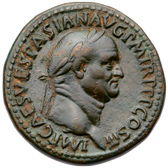 |
Vespasian. Æ Sestertius (28.46 g), AD 69-79. Judaea Capta type. Rome, AD 71. IMP CAES VESPASIAN AVG P M TR P P P COS III, laureate head of Vespasian right. Rev. IVDAEA CAPTA, S C in exergue, palm tree; to left, bound captive standing right before pile of arms; to right, Judaea seated right in attitude of mourning. Hendin 1500; RIC 159; BN 490; BMC 533. A lovely example with glossy chocolate-brown patina. We note some minor pitting on the reverse. Choice Very Fine. Estimate Value $7,500 - UP
From the S. Moussaieff Collection, This lot has been officially exported from Israel through the Israel Antiquities Authority.
The elements of the reverse type include a palm-tree flanked on the left by the emperor, with his foot on a helmet, and on the right, by the personified Judaea, seated to right on a cuirass. In the scene, the emperor is representative of the vast power of Rome. His foot on a helmet of the defeated enemy and his large parazonium symbolize the might of the dominant victor. The emperor is drawn on a much larger scale than is the much more diminutively wrought personified Judaea. The downcast Judaea is seated upon a cuirass, which here represents the spoils of her defeated army. Her pose connotes the humiliation of destruction, captivity and exile. This image was designed both as an exultation of the empire and as a warning to any other province that might be contemplating rebellion.
View details and enlarged photos
| Realized
$16,200 |
Lot 197 |
 |
Vespasian. Æ Sestertius (22.92 g), AD 69-79. Judaea Capta type. Rome, AD 71. IMP CAES VESPASIAN AVG P M TR P P P COS III, laureate head of Vespasian right. Rev. VI-C-TORIA AVGVSTI, S C in exergue, Victory standing right, foot on helmet, inscribing shield set on palm tree; to right of tree, Jewess seated right in attitude of mourning. RIC 221; BN 561; BMC 582-3; Hendin 1508. Greenish-brown patina. Very Fine. Estimate Value $600 - UP
From the Palm Desert Collection. Purchased from A. Saslow in the 1980s.
View details and enlarged photos
| Realized
$990 |
Lot 198 |
 |
Domitian. Æ As (10.61 g), as Caesar, AD 69-81. Rome, AD 72. CAESAR AVG F DOMITIANVS COS DES II, laureate head of Domitian right. Rev. S C in exergue, emperor, holding eagle-tipped scepter and reins, driving slow quadriga right. Hendin 1559; RIC 490; BN 639; BMC 646. A magnificent example! Dark green patina. Very rare and seldom offered. We note some light smoothing in the reverse fields. Choice Very Fine. Estimate Value $750 - UP
From the Palm Desert Collection. Purchased from D. Hendin in the 1980s.
View details and enlarged photos
| Realized
$2,880 |
Lot 199 |
 |
Divus Vespasian. Gold Aureus (6.96 g), died AD 79. Judaea Capta type. Rome, under Titus, AD 80/1. DIVVS AVGVSTVS VESPASIANVS, laureate head of Vespasian right. Rev. EX S C across field, Victory advancing left, placing shield on trophy, below which Judaea seated left in attitude of mourning. Hendin 1581; RIC 363; BN 89; BMC 112, note; Calicó 628. Very Rare. Some scattered marks, none too serious. Fine. Estimate Value $3,750 - UP
From the S. Moussaieff Collection, This lot has been officially exported from Israel through the Israel Antiquities Authority.
View details and enlarged photos
| Realized
$6,300 |
Lot 200 |
 |
Vespasian. Æ As (10.74 g), AD 69-79. Judaea Capta type. Lugdunum, AD 77/8. IMP CAES VESPASIAN AVG COS III P P, laureate head of Vespasian right. Rev. IVDAEA CAPTA, S C in exergue, palm tree; to right, Judaea seated on ground in attitude of mourning; arms around. Hendin 1561 corr. (obv. legend); RIC 1233; Lyon 91; BN 846; BMC -. Very Rare. Reddish-brown patina, pitted surfaces. Sharpness of Very Fine. Estimate Value $1,000 - UP
From the S. Moussaieff Collection, This lot has been officially exported from Israel through the Israel Antiquities Authority.
View details and enlarged photos
| Realized
$2,160 |
Lot 201 |
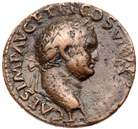 |
Titus. Æ As (10.74 g), as Caesar, AD 69-79. Judaea Capta type. Lugdunum, under Vespasian, AD 77/8. T CAES IMP AVG F TR P COS VI C[ENSOR], laureate head of Titus right, globe at point of bust. Rev. IVDAEA CAPTA, S C in exergue, Judaea seated right beneath palm tree, resting head on hand in attitude of mourning; behind, arms. Hendin 1562; RIC 1268; Lyon 115 and 121-2; BN 872. Very Rare. Reddish-brown patina. Scattered obverse marks. Very Fine. Estimate Value $500 - UP
From the Palm Desert Collection. Purchased from Superior in the 1970s or 1980s.
View details and enlarged photos
| Realized
$960 |
Lot 202 |
 |
Vespasian. Æ Quadrans (1.88 g), AD 69-79. Rome, AD 72/3. IMP VESP[ASI]AN AVG, palm tree. Rev. P M TR P P P COS IIII, S C across field, vexillum. Hendin 1571; RIC 408; BMC 626. Glossy chocolate brown patina and probably the finest known. Nearly Mint State. Estimate Value $500 - UP
From the Palm Desert Collection. Ex Abraham Bromberg Collection, pt. I (Superior, 5 December 1991), 302.
View details and enlarged photos
| Realized
$1,200 |
Lot 203 |
 |
Titus. Silver Denarius (3.21 g), AD 79-81. Rome, AD 80. IMP TITVS CAES VESPASIAN AVG P M, laureate head of Titus right. Rev. TR P IX IMP XV COS VIII P P, trophy flanked by Judaea, on left, seated left in attitude of mourning, and bound Jew on right. Hendin 1584; RIC 102; BMC 37; RSC 306. Attractive multi-color toning. Extremely Fine. Estimate Value $500 - UP
From the Palm Desert Collection. Purchased from A. Saslow in the 1980s.
View details and enlarged photos
| Realized
$2,100 |
Lot 204 |
 |
Titus. Silver Denarius (3.37 g), AD 79-81. Rome, AD 79. IMP TITVS CAES VESPASIAN AVG P M, laureate head of Titus left. Rev. TR P IX IMP XV COS VIII P P, trophy flanked by Judaea, on left, seated left in attitude of mourning, and bound Jew on right. Hendin 1584a; RIC 103; BMC p. 230, note; RSC 307. Scarce. Lightly toned. Very Fine. Estimate Value $300 - UP
From the Palm Desert Collection. Purchased from V. England in the 1980s.
View details and enlarged photos
| Realized
$1,080 |
Lot 205 |
 |
Divus Vespasian. Silver Denarius (3.40 g), died AD 79. Judaea Capta commemorative. Rome, under Titus, AD 80/1. DIVVS AVGVSTVS VESPASIANVS, laureate head of Vespasian right. Rev. EX S C across field, Victory advancing left, attaching shield to trophy below which Jewess seated left, in attitude of mourning. Hendin 1586; RIC 364; BN 90; BMC 112; RSC 144. Nicely toned. Extremely Fine. Estimate Value $500 - UP
From the Palm Desert Collection. Purchased from NFA in the 1980s.
View details and enlarged photos
| Realized
$1,380 |
Lot 206 |
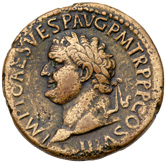 |
Titus. Æ (orichalcum) Sestertius (23.90 g), AD 79-81. Judaea Capta type. Rome, AD 80. IMP T CAES VESP AVG P M TR P COS VIII, laureate head of Titus left. Rev. IVD CAP / S C in two lines across field, palm tree; to left, Judaea seated on ground in attitude of mourning; to right, bound captive standing right, captured arms before him. Hendin 1593c; RIC 153; BN 159; BMC 169-70. Cleaned and smoothed, in spite of these problems, very rare and seldom seen better. Sharpness of Very Fine. Estimate Value $3,500 - UP
From the S. Moussaieff Collection, This lot has been officially exported from Israel through the Israel Antiquities Authority.
View details and enlarged photos
| Realized
$3,840 |
Lot 207 |
 |
Nerva. Æ Sestertius (26.44 g), AD 96-98. Rome, AD 97. IMP NERVA CAE[S AVG] P M TR P COS III P P, laureate head of Nerva right. Rev. FISCI IVDAICI CALVMNIA SVBLATA, S C across field, palm tree with two large bunches of dates. Hendin 1603b; RIC 82; BN 97; BMC 105. Very Rare and historically important. Reddish-brown and tan patina, light scratches and marks in fields. Sharpness of Very Fine. Estimate Value $4,500 - UP
From the S. Moussaieff Collection, This lot has been officially exported from Israel through the Israel Antiquities Authority.
Nerva's "Fisci Ivdaici" Sestertius: According to the Roman historian Suetonius: "More than any other, the Fiscus Iudaicus was administered very severely; and to it were brought, or reported, those who either had lived the life of a Jew unprofessed, or concealing their origin, had not paid the tax imposed upon by the people. I remember that it was of interest to me during my youth when a ninety-year-old man was brought before the procurator and a very crowded court to see whether he was circumcised."
View details and enlarged photos
| Realized
$5,760 |
Lot 208 |
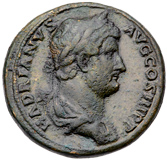 |
Hadrian. AE Sestertius (28.70 g.), AD 117-138. Struck in Rome 134-138 CE. HADRIAN AVGCOSIIIPP, Bust of Hadrian right, laureate, cuirassed and draped. Reverse: Hadrian togate, stands r., extends r. hand to raise a kneeling draped woman, l., two children stand l., in front of her, one carries a palm branch, the second does not, a third child, also carries a palm branch and stands behind her to l; IVDAEA in exergue, S C to left and right of scene. Hendin ___; Cohen ___; BMC ___. For a reverse die link see Los Sestercios Imperio Romano, Vol. II, Juan R. Cayon, 459A, page 137. Glossy chocolate brown with slight iridescense., smoothing in the fields, Probably unique and highly important. Choice Very Fine. Estimate Value $30,000 - UP
From the S. Moussaieff Collection, This lot has been officially exported from Israel through the Israel Antiquities Authority.
This reverse type appears to be a totally new and previously umpublished type with Judaea represented in a kneeling position and extending her hand to the emperor Hadrian who receives her. The earliest representation of this scene is taken from a medallion published in 1740 from a museum in Venice, Museo pis ano olim Corrario animadversions Furthermore, Jonathan Grimaldi of Numismatica Ars Classica NAC AG in London, found an important note in a "Bollettino dei Musei Comunali di Roma" of 1993 where the author (Antonio Giuliano) wrote that the above piece could be in Vienna instead of Venice.
Additional comment by David Hendin, American Numismatic Society and author of a Guide to Biblical Coins:
This is an extremely rare coin type of Hadrian that cross-references Hadrian's RESTITVTORI (celebrating Hadrian as "the restorer of…") coins, but is also related to Hadrian's ADVENTVI (celebrating "the arrival of…" Hadrian) coin series.
Unlike any of the other Hadrian coins referring to Judaea, this coin depicts a kneeling personification of Judaea. Hadrian's coins referencing ADVENTVI AVE IVDAEAE or simply IVDAEA, all depict the personification of Judaea greeting the emperor from a standing position, flanked by children and somethimes an altar. This coin shows three children and no altar. All of the other sestertii in Hadrian's RESTITVTORI have similar scenes in which each province kneels before the emperor. Thus, by iconography we can link the coin to the RESTITVTORI series as well as to the ADVENTI series, the only other Hadrian coin series that mentions Judaea.
Thus, this coin conveys an official message that when Hadrian visited Judaea in 130 AD, he found Jerusalem still in ruins from its destruction by Titus in 70 AD. Hadrian renamed Jerusalem as Aelia Capitolina and thus became "the restorer of Judaea." Even though the reverse legend does not describe this completely, the images make the message perfectly clear. Hadrian's visit and renaming of the Holy City set into motion the subsequent Bar Kokhba War (132-135 AD), which Rome won, but at no small cost to Hadrian and his armies.
View details and enlarged photos
| Realized
$63,000 |
Lot 209 |
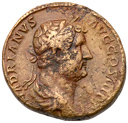 |
Hadrian. Æ As (13.18 g), AD 117-138. Rome, AD 134-138. HADRIANVS AVG COS III P P, laureate and draped bust of Hadrian right. Rev. ADVENTV-I AVG IV]DAEAE, S C in exergue, emperor standing right, extending hand towards Judaea standing left, holding patera in and cup; at her feet, two children before her, one behind, each holding a palm branch; between the emperor and Judaea, a lit altar. Cf. Hendin 1606 (only two children on reverse); RIC 893; cf. BMC 1661. Extremely Rare. Light brown patina. Very Fine. Estimate Value $7,500 - UP
From the S. Moussaieff Collection, This lot has been officially exported from Israel through the Israel Antiquities Authority.
This copper as of Hadrian belongs to that emperor's popular "travel series" which commemorated his visits to various provinces throughout the Empire, including Hispania, Macedonia, and Egypt among others. This particular issue celebrates a visit to Judaea. On the reverse, the togate emperor greets the female personification of Judaea, who offers a sacrifice in his honor and is surrounded by three children holding palm branches. The amicable relationship between Hadrian and Judaea expressed by the type belies the deep crisis that unfolded in the province under Hadrian.
In AD 130, Hadrian passed through Judaea on his way to Egypt. During this trip he saw the ruins of Jerusalem left from the destruction of the city by Titus in AD 70 and vowed to rebuild it as the capital of the province. As a philhellene and respecter of antiquity, Hadrian was generally concerned with the upkeep of the old cities of the Empire. Unfortunately, he decided not to restore the city as a Jewish religious center, but rather as a pagan capital dedicated to the cult of Jupiter Capitolinus and renamed as Aelia Capitolina. It is not entirely clear whether this refoundation was really intended by Hadrian as an affront to Jewish sensibilities or rather as a misguided attempt to bring Judaea into the Hellenic cultural oikeumene that the emperor was constructing throughout the Greek East. The Seleukid king Antiochos IV Epiphanes (175-164 BC) had courted disaster with similar attempts to Hellenize Jerusalem and Judaea and centuries later, Hadrian had not learned from the mistake. Just as Antiochos' attempts at Hellenization had sparked the Maccabean Revolt against Seleukid rule, Hadrian's refoundation of Jerusalem horrified the remaining Jewish inhabitants of Judaea and sparked the armed uprising known as the Bar Kokhba War (AD 132-135). Rebels under the leadership of the messianic figure, Simon bar Kokhba, fought a bloody guerilla war and inflicted severe losses on the Roman legions before they were finally crushed. Enraged by the revolt and its high cost in men and money, Hadrian took steps to eradicate Jewish nationalism by burning sacred texts, forbidding the use of Torah law or the Hebrew calendar, and changing the name of the province from Judaea to Syria Palaestina.
Although sometimes associated with a supposed imperial visit after the conflict, the happy reverse type and the use of the name Judaea on this travel issue strongly suggests production in AD 130 and the period before the outbreak of the Bar Kokhba War. The personification of Judaea offering a sacrifice over a pagan altar (an image that would have been offensive to many Jews of the period) underlines the kind of cultural insensitivity that incited the conflict in the first place. Although Hadrian was himself a great lover of Hellenism, he was very much blind to the fact that it was not something for everyone and that its imposition would not always result in the joyous reception depicted on the reverse of this coin.
View details and enlarged photos
| Realized
$8,700 |
Lot 210 |
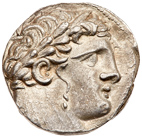 |
Phoenicia, Tyre. Silver Shekel (14.53 g), ca. 126/5 BC-AD 65/6. CY 49 (78/7 BC). Laureate bust of Melkart right, lion's skin tied at neck. Rev. TYPOY IEPAΣ KAI AΣYΛOY, eagle standing left on prow, palm on far wing; in left field, date (ΘM) and club; in right field, Δ; between legs, 'bet'. Hendin 1618; DCA Suppl. 121. Lightly toned. Superb Extremely Fine. Estimate Value $600 - UP
From the Palm Desert Collection. Purchased from Superior in the 1980s.
View details and enlarged photos
| Realized
$1,440 |
Lot 211 |
 |
Phoenicia, Tyre. Silver Shekel (14.30 g), ca. 126/5 BC-AD 65/6. CY 40 (78/7 BC). Laureate bust of Melkart right, lion's skin tied at neck. Rev. TYPOY IEPAΣ KAI AΣYΛOY, eagle standing left on prow, palm on far wing; in left field, date (L M) and club; in right field, Δ; between legs, 'bet'. Hendin 1618; DCA Suppl. 99. Well struck on a full flan and well centered. Choice Very Fine. Estimate Value $500 - UP
From the Palm Desert Collection. Purchased from D. Hendin in the 1980s.
View details and enlarged photos
| Realized
$1,020 |
|
|